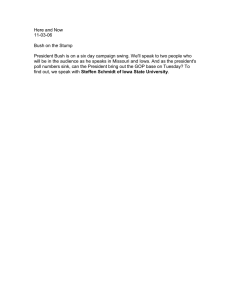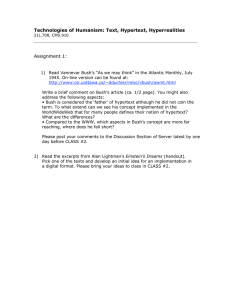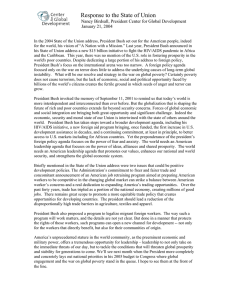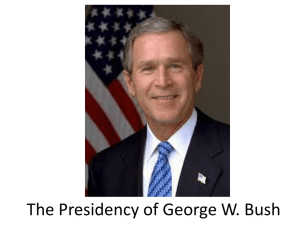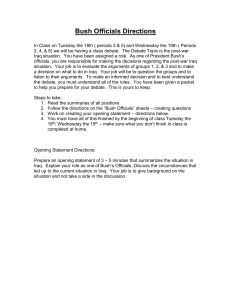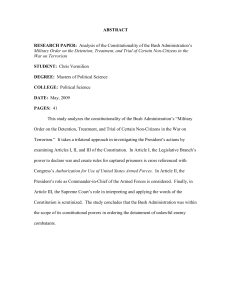The New Millennium
advertisement
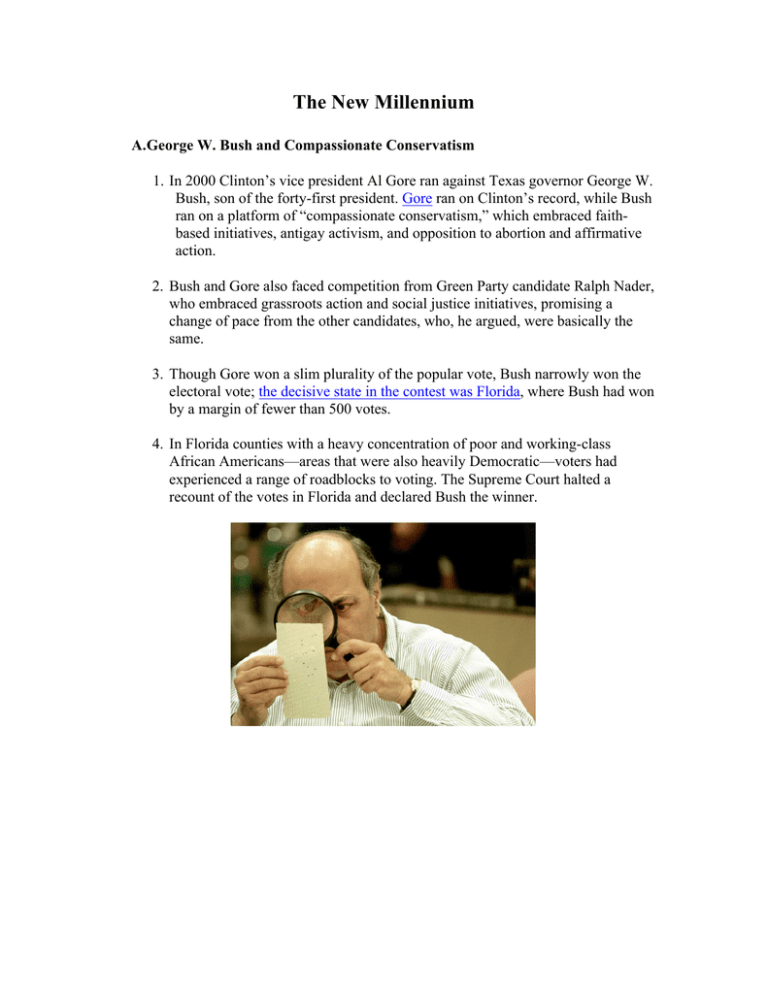
The New Millennium A.George W. Bush and Compassionate Conservatism 1. In 2000 Clinton’s vice president Al Gore ran against Texas governor George W. Bush, son of the forty-first president. Gore ran on Clinton’s record, while Bush ran on a platform of “compassionate conservatism,” which embraced faithbased initiatives, antigay activism, and opposition to abortion and affirmative action. 2. Bush and Gore also faced competition from Green Party candidate Ralph Nader, who embraced grassroots action and social justice initiatives, promising a change of pace from the other candidates, who, he argued, were basically the same. 3. Though Gore won a slim plurality of the popular vote, Bush narrowly won the electoral vote; the decisive state in the contest was Florida, where Bush had won by a margin of fewer than 500 votes. 4. In Florida counties with a heavy concentration of poor and working-class African Americans—areas that were also heavily Democratic—voters had experienced a range of roadblocks to voting. The Supreme Court halted a recount of the votes in Florida and declared Bush the winner. 5. Though Bush won by only a slim margin, he governed as though he had won a large majority, showing little interest in compromise and embracing his conservative base. 6. Bush’s base came out of the evangelical Christian community, and Bush brought faith-based initiatives to the forefront of his agenda; Bush also opposed gay marriage, abortion, and stem cell research. 7. Bush also embraced economic conservatism, cutting taxes and putting money back into the pockets of the very wealthy without cutting spending. The Bush administration also deregulated business practices. 8. Policy changes included the passage of the No Child Left Behind Act, which emphasized standardized testing as a key measure for educational systems and based federal funding for school systems on test outcomes. 9. The 2003 Medicare Prescription Drug, Improvement, and Modernization Act provided funding to lower the cost of prescription drugs for senior citizens and was another significant policy measure that reflected Bush’s compassionate conservative agenda. B. The United States at War 1. Bush had little foreign policy experience and vowed to use the military solely to fight and prevent war, rather than for nation building, but he relied on his vice president Richard Cheney, Secretary of Defense Donald Rumsfeld, and Condoleezza Rice to guide his foreign policy. 2. On September 11, 2001, the attack on the World Trade Center and the Pentagon transformed Bush into a foreign policy president. Bush deployed military forces in Afghanistan and Iraq and created a new executive department, the Department of Homeland Security. 3. In invading Afghanistan, the United States hoped to capture Osama bin Laden and overthrow the Taliban regime in favor of a pro-American government. 4. At home, Bush pushed for the passage of the Patriot Act, which expanded investigatory agencies in order to detect and prevent terrorist activities. Tactics included wiretapping, reading e-mail messages, and searching medical, financial, and library borrowing records. Computer technology not only facilitated terrorist networking, it also aided investigatory measures to track down threats. 5. With anti-Muslim prejudice on the rise in the wake of the 2001 terrorist attack, most Americans embraced the Patriot Act. Muslims and other Arab Americans, including Sikhs, encountered prejudice and violence. 6. In spite of criticism of the Patriot Act, including charges that it resembled the post–World War I Red scare measures, Congress renewed the legislation in 2006. 7. Though the Taliban government in Afghanistan was toppled, that fight was just one piece of a much larger battle with Cheney and Rumsfeld at the helm. 8. That battle expanded into the Middle East, as Bush laid the foundations for the Bush Doctrine, which argued on behalf of preventive war as a way to depose extremist governments that might threaten national security, even if the danger was not immediate. 9. In January 2002, Bush declared Iran, Iraq, and North Korea to be part of an “axis of evil” that was a threat to U.S. security, and he determined that his administration’s goals would include removing Iraqi dictator Saddam Hussein from power, which would allow the United States to attempt to dismantle Iran’s radical Islamic government. 10. In his effort to convince the American public that Iraq warranted American military attention, he linked Hussein to the September 11 attacks and stated that Iraq was building an arsenal of “weapons of mass destruction.” Both of these claims were false. 11. Though an antiwar movement had some momentum, most Americans supported Bush’s mission, and in March 2003 the United States began bombing Baghdad as part of a strategy known as “shock and awe.” Within a few weeks Hussein was in hiding, and Bush prematurely stated that “major combat operations” in Iraq were complete. 12. The war continued even without Hussein leading Iraq, and more than 4,000 U.S. soldiers died in the conflict. The U.S. invasion triggered a civil war among Sunnis, Shi’ites, and Kurds, all of whom hoped to win power; in addition, though al-Qaeda was not in Iraq prior to the invasion, the instability created a ripe environment for al-Qaeda forces to gain influence. 13. U.S. troops on the ground in Iraq were exhausted, undertrained, and at times tactless in dealing with their duties. For instance, at the prison Abu Ghraib, American soldiers took photos of themselves abusing Iraqi prisoners. Tours of duty were long and repeated. 14. To supplement the military’s support capabilities, the United States awarded contracts to companies such as Halliburton, which was closely linked to the vice president. 15. Bush won reelection in 2004 by promising to complete the Iraq War; his opponent, Massachusetts senator John Kerry, criticized Bush’s efforts in Iraq. C. Bush’s Second Term 1. In spite of Bush’s promise to end the Iraq War, violence continued, and by 2008 polls showed that 54 percent of Americans believed that the invasion had been a mistake and that the U.S. troops should return home. 2. In spite of mass public criticism, the Bush administration continued to carry out domestic and intelligence policies that violated civil liberties. A particular target for criticism was the U.S. military base in Guantánamo, Cuba, where more than six hundred prisoners were subject to harsh interrogation techniques without the benefit of counsel. Though conditions at the prison improved after 2006, it remained a subject of criticism. 3. In addition to enacting unpopular foreign policy, Bush was criticized for his administration’s slow response to Hurricane Katrina, which hit Louisiana and Mississippi on August 29, 2005, flooding the city of New Orleans and stranding some 50,000 people in the city. 4. The flooding killed at least 1,800 Gulf Coast residents, and evacuees stayed in the Superdome football stadium without adequate accommodations; Bush’s slow response contributed significantly to the chaos in the aftermath of the storm. 5. In the 2006 midterm elections, Democrats won majorities in the House and Senate, but little changed: Osama bin Laden was still alive, and al-Qaeda retained strongholds in Pakistan and Yemen; U.S. enlistments were low and comprised mainly of poor minorities; and the Bush administration failed to resolve the mounting tensions in Israel and Palestine. 6. Though Iraq did not have the weapons of mass destruction that Bush had pointed to as justification for war, nuclear proliferation continued as Iran and North Korea sought nuclear weapons. In 2006 North Korea conducted underground nuclear tests.
